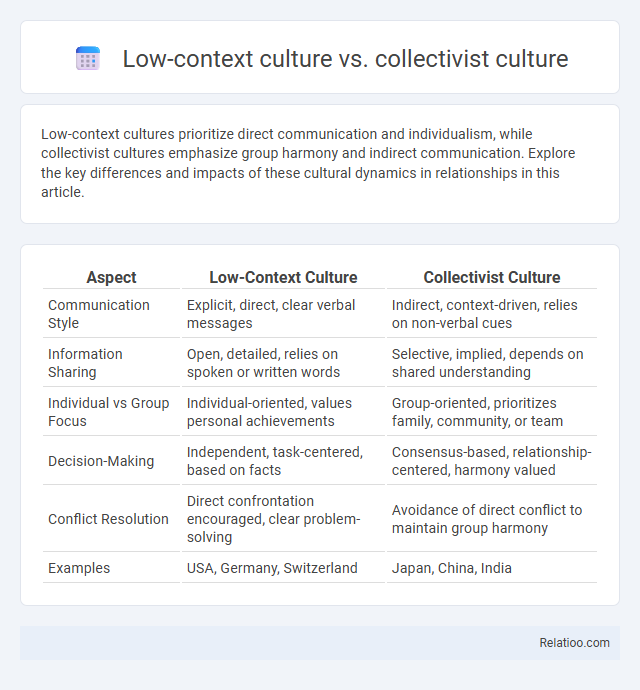Low-context cultures prioritize direct communication and individualism, while collectivist cultures emphasize group harmony and indirect communication. Explore the key differences and impacts of these cultural dynamics in relationships in this article.
Table of Comparison
| Aspect | Low-Context Culture | Collectivist Culture |
|---|---|---|
| Communication Style | Explicit, direct, clear verbal messages | Indirect, context-driven, relies on non-verbal cues |
| Information Sharing | Open, detailed, relies on spoken or written words | Selective, implied, depends on shared understanding |
| Individual vs Group Focus | Individual-oriented, values personal achievements | Group-oriented, prioritizes family, community, or team |
| Decision-Making | Independent, task-centered, based on facts | Consensus-based, relationship-centered, harmony valued |
| Conflict Resolution | Direct confrontation encouraged, clear problem-solving | Avoidance of direct conflict to maintain group harmony |
| Examples | USA, Germany, Switzerland | Japan, China, India |
Defining Low-Context Culture
Low-context culture emphasizes direct, explicit communication where meaning is conveyed primarily through spoken or written words rather than context or nonverbal cues. It contrasts with collectivist cultures, which rely heavily on shared experiences, social roles, and group harmony to interpret messages, often using indirect communication. Understanding low-context culture is crucial for effective interaction in societies like the United States and Germany, where clarity and straightforwardness in communication are highly valued.
Understanding Collectivist Culture
Collectivist culture emphasizes group harmony, shared goals, and interdependence, contrasting with low-context culture's preference for explicit communication and individualism. In collectivist societies, context, relationships, and implicit understanding play crucial roles in interactions, while low-context cultures rely heavily on clear, direct messages. Recognizing these differences is essential for effective communication and collaboration in multicultural environments.
Key Differences Between Low-Context and Collectivist Cultures
Low-context cultures rely on explicit communication, where messages are clear and detailed, while collectivist cultures emphasize group harmony and indirect communication to maintain relationships. You will find that low-context cultures prioritize individualism and directness, whereas collectivist cultures value interconnectedness and often use nonverbal cues to convey meaning. Understanding these key differences helps enhance cross-cultural communication and reduces misunderstandings in diverse environments.
Communication Styles: Explicit vs Implicit
Low-context cultures rely on explicit communication, where messages are clear, direct, and spelled out to ensure understanding without much need for interpretation. Collectivist cultures often use implicit communication, emphasizing nonverbal cues and context to convey meaning, which fosters group harmony and shared understanding. Your ability to navigate these differences in communication styles is crucial for effective interaction across diverse cultural settings.
Role of Relationships and Social Structure
In low-context cultures, communication is explicit and relationships are often task-oriented, with less reliance on social hierarchies, enabling direct interactions regardless of social status. Collectivist cultures emphasize strong social networks and group harmony, where relationships are foundational and social roles are clearly defined within a tight-knit community. High-context cultures rely on implicit communication and deep understanding of social context, where relationships and social structure are intertwined, influencing behavior and interactions significantly.
Decision-Making Processes in Each Culture
Decision-making processes in low-context cultures emphasize direct communication, individual responsibility, and explicit information exchange, enabling efficient and transparent decisions. Collectivist cultures prioritize group consensus, harmony, and relational dynamics, often involving extended consultations to ensure decisions align with collective values and maintain social cohesion. Your approach to decision-making adapts significantly depending on whether the cultural context leans toward low-context individualism or collectivist frameworks, impacting communication style and collaboration methods.
Conflict Resolution Approaches
Low-context cultures prioritize explicit communication and direct conflict resolution through clear verbal expression and logical argumentation. Collectivist cultures emphasize harmony and group cohesion, often resolving conflicts indirectly through mediation, consensus-building, or deference to authority. In contrast, high-context cultures rely on implicit communication, nonverbal cues, and relational understanding to manage conflicts without overt confrontation.
Workplace Dynamics and Teamwork
Low-context cultures emphasize direct communication and clear instructions, fostering transparency and efficiency in workplace dynamics, while collectivist cultures prioritize group harmony, loyalty, and consensus, shaping teamwork through strong interpersonal relationships and shared goals. Your team's performance improves by balancing explicit communication with an understanding of collective values and social context. Navigating these cultural dimensions enhances collaboration, reduces misunderstandings, and promotes a cohesive work environment.
Adapting to Cross-Cultural Interactions
Adapting to cross-cultural interactions requires understanding that low-context cultures emphasize direct, explicit communication relying on clear, verbal messages, while collectivist cultures prioritize group harmony, indirect communication, and contextual cues. In low-context cultures such as the United States and Germany, straightforwardness and clarity are valued to avoid misunderstandings. Navigating cross-cultural communication effectively involves recognizing these differences, tailoring communication styles, and demonstrating cultural sensitivity to build trust and collaboration.
Implications for Global Business and Society
Low-context cultures emphasize explicit communication and individualism, facilitating clear, direct negotiations in global business but potentially overlooking group harmony and relational nuances prevalent in collectivist cultures. Collectivist cultures prioritize group goals, community cohesion, and implicit communication, which can enhance team loyalty and long-term partnerships but may pose challenges in transparency and decision-making speed for multinational enterprises. Understanding these cultural frameworks is crucial for international businesses to tailor management styles, marketing strategies, and communication methods, ensuring effective collaboration and cross-cultural integration in diverse societies.

Infographic: Low-context culture vs Collectivist culture
 relatioo.com
relatioo.com